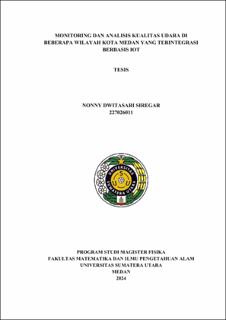| dc.description.abstract | The background of this research is the importance of monitoring air quality in the
industrial and non-industrial areas, especially in Medan, Indonesia. The growth of the
industrial sector and the increased use of transportation can raise air pollution caused
by the hazardous gas emission such as NO2 and CO, as well as microscopic particles
like PM2.5 which have significant impact on human health. They can expecially cause
respiratory diseases, heart problems, and even premature death. Ropid technological
development in the Internet of Things (IoT) can detect air quality and send the result
of sensor reading through the internet without cable to Android devices or Pex. The
objective of this research is to design an air quality monitoring device connected to
hazardous gasses, NO2 and CO, using Mics-6814 sensor, and to measure the content
of PM2.5 microscopic particles using an loT based-integrated PMS5003 sensor
accurately and in real- time, analyzing the result of air quality monitoring in the
research location. The research methodology involves measuring air quality
parameters such as PM2.5, CO, NO2, temperature, and humidity using an IoT basedintegrated
designing device. The research location consists of three points: the
industrial vicinity and the KIM (Medan Industrial Area) residence in Mabar, Tanjung
Morawa industrial area, and the campus of Universitas Sumatera Utara. Data in
figures will be tabulated from the research result within 7 hours in three days, based
on the designated time. The results of the research show that the designed air quality
monitoring system can measure temperature, humidity, and the content of PM2.5.
NO2, CO accurately and in real-time. The data collected from various research
locations show different trends. Overall, the air quality in the research location is the
category of healthy; it has no impact on human, animal, and plant health according to
the Decree of the Minister of Environment and Forestry of the Republic of Indonesia.
It is recommended that the next researchers choose components that are more sensitive
in detecting air quality and consider environmental conditions that can decrease any
value deviations from the sensor. | en_US |


